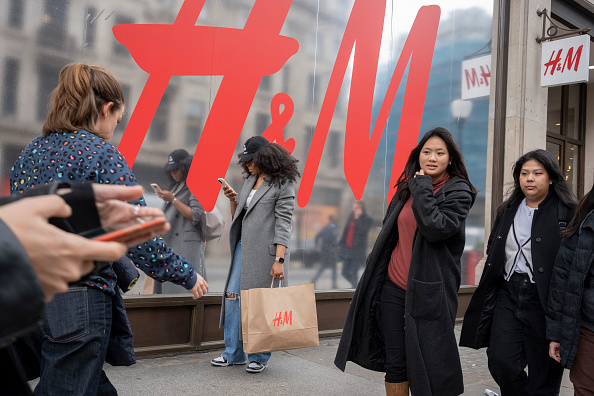Fashion’s New Look for Stores: Bigger, Better, Fewer
Zara and H&M are adding beauty salons and new digital features to physical locations to renew their appeal
LONDON—Fashion retailers have found a way to make their shops dazzle customers again: make them more like Apple stores.
Brands including H&M and Zara have closed hundreds of stores in recent years to cut costs as more shoppers turn to e-commerce. Now they are investing in those that remain to woo customers in ways they can’t online.
The new-look stores are typically larger and more spacious, offer services such as beauty salons, repair stations and coffee shops, and enable new digital features such as apps that allow shoppers to rummage virtually through the storeroom.
“Now it’s about engaging with consumers and giving them an experience,” said Henrik Nordvall, manager of H&M’s U.K. business.
At the brand’s recently redesigned store on London’s Regent Street, foot traffic matters more than sales figures, Nordvall said. While in-store sales are still strong, many customers spend time there developing an affinity with the brand and then buy clothes online later, he added.
The refurbished store is home to a floor-to-ceiling TV screen that the company says is the biggest in any store in Europe, a beauty bar for customers to book nail or eyelash treatments, and a rental section where shoppers can borrow selected items, especially relatively expensive clothes from H&M’s designer collaborations.
Since the changes, the average duration of a customer visit has increased substantially, said Nordvall, who declined to provide specific numbers.
By turning their stores into destinations that shoppers actively seek out and spend time in—a model that Apple honed with its roomy, landmark stores filled with usable gadgets—the fashion retailers are redefining the clothing store for the digital age.
Retailers once needed a large network of stores “to reach people, but now they have the internet for that,” said Patricia Cifuentes, an analyst at the asset manager Bestinver. “Now stores are about brand image. They’re like tourist destinations.”
Not every retailer is following the approach of the big global fashion brands. Macy’s, for example, is opening smaller stores as a way of bringing its brand to places where customers run their daily errands. The electronics chain Best Buy is closing larger locations and opening small stores instead.
But for global fashion’s heavy hitters the shift toward fewer but better stores is well under way. While the investment could backfire if the stores fail to draw sustained traffic, for now the strategy appears to be working.
Inditex, the parent of Zara, has eliminated a quarter of its stores since 2018 and now has 5,745 locations across its brand stable, which also includes Bershka and Massimo Dutti. Yet the Spanish group’s total revenue from stores increased 8% in 2022 compared with four years earlier, with each store selling 30% more on average, Chief Executive Officer Oscar Garcia Maceiras said on a recent earnings call.
After closing its weaker locations and upgrading the rest, “We have been left with a network of bigger, better and more beautiful stores in the best retail destinations globally,” Garcia said.
Despite operating fewer stores overall, Inditex increased its capital expenditure budget for 2023 by 14% to 1.6 billion euros, equivalent to about $1.7 billion, half of which is earmarked to make improvements to stores.
Much of that money is being spent on the rollout of a new Zara store design—including at new U.S. locations in Baton Rouge, La., and San Antonio—to make the shopping experience more enjoyable.
Essential to the new layouts is making stores feel roomier by having more open space between displays so customers don’t feel crowded. With more open space, stores will increasingly have discrete in-store boutiques to highlight individual collections.
Zara has a team of in-house architects who design its stores, and uses pilot stores at its headquarters in Spain to experiment with new layouts.
Garcia, who regularly visits Zara stores around the world, said in a recent interview that store managers routinely tell him they want to expand because only larger stores are able to accommodate most or all of Zara’s range.
The Zara store in Miami is one beneficiary of the move toward bigger and better: It is doubling in size, according to Garcia, to provide the more spacious experience the company wants to deliver.
Bigger stores are more productive, Zara has found. Though stores are getting larger, sales per square foot is now up 16% relative to 2019, Garcia said.
Zara is cramming its stores with new tech such as automatic return and collection points, as well as self-checkout areas. Customers can use the Zara app to check the contents of the storeroom to see if an item is available in their sizes, for example.
H&M has shrunk its store count 14% from its 2019 peak to 4,375 outlets today. The company doesn’t break down its revenue into physical and online, and says the two parts of the business are complementary.
Increasingly, stores “are a way for our customers to get inspiration,” CEO Helena Helmersson said in a recent interview.
H&M upped its capital spending budget 43% for 2023 to roughly $1 billion, partly to push ahead with store modernisation.
Even before the Covid-19 pandemic, H&M’s leaders recognized it was time to update the physical store to offer a more engaging experience, said Nordvall, the U.K. manager. When the pandemic led to a surge in online sales, the company accelerated its effort to redesign its stores, he said.
The revamp of the Swedish brand’s store on London’s Regent Street was aimed at encouraging customers to spend more time there. It has a secondhand area, Lego sculptures in the children’s section and fitting rooms with a built-in selfie function.
H&M also uses the store to host events for shoppers who sign up for its membership program. In November, it held a party to mark the launch of a collaboration with the fashion house Rabanne.
The Japanese brand Uniqlo is still expanding in Western markets, where its footprint is significantly smaller than H&M and Zara, but it is also opening so-called destination stores.
The chain’s recently opened store in London’s Covent Garden is located in a converted Victorian-era carriage works building, where shop floors loop around a brightly sunlit courtyard beneath a vaulted glass roof. There is a Japanese tea shop upstairs with a rooftop balcony, and a florist downstairs.
Visitors can use a machine to print their own T-shirt designs, have clothes altered or mended at the store’s repair station, and lounge in comfy chairs while browsing coffee-table books.
While online sales are growing, destination stores “have become the driver of European earnings,” as well as places where the brand communicates what it stands for, said Taku Morikawa, the CEO of Uniqlo Europe, during a recent earnings presentation.
Only a memorable in-store experience will make customers trust and admire your brand, he said.
 Copyright 2020, Dow Jones & Company, Inc. All Rights Reserved Worldwide. LEARN MORE
Copyright 2020, Dow Jones & Company, Inc. All Rights Reserved Worldwide. LEARN MORE
This stylish family home combines a classic palette and finishes with a flexible floorplan
Just 55 minutes from Sydney, make this your creative getaway located in the majestic Hawkesbury region.
More millionaires call New York City home than anywhere else in the world, according to a report from international wealth migration specialists Henley & Partners.
The Big Apple, which has seen its high-net-worth population jump by 48% over the past decade, is home to 349,500 millionaires, 744 centi-millionaires—those with liquid investable wealth of over US$100 million—and 60 billionaires, according to the firm, which collaborated with data intelligence firm New World Wealth for the analysis.
The city also ranked as the top spot for millionaires last year.
California’s Bay Area, encompassing San Francisco and the tech-mecca of Silicon Valley, ranked second. Wealth in the Bay Area has grown at one of the fastest rates in the world, increasing its number of wealthy citizens by a sizeable 82% over the past decade. It’s now home to 305,700 millionaires, 675 centi-millionaires, and 68 billionaires.
New York and the Bay Area were among 11 areas in the U.S. on the top 50 ranking, making the country the world’s foremost hub of moneyed residents.

Across the pond, London, which ranked as the wealthiest city in the world for many years, tumbled down the ranking, and now sits in fifth place with just 227,000 millionaires, 370 centi-millionaires, and 35 billionaires, a decline of 10% over the past decade, said the report, which was released earlier this week.
Cities with the fastest growing wealth, meanwhile, can be found in China.
Shenzhen’s wealthy population is snowballing most, with their numbers surging by 140% in the last 10 years, the report said.
“Hangzhou has also experienced a massive 125% increase in its [high-net-worth] residents, and Guangzhou’s millionaires have grown by 110% over the past decade,” said Andrew Amoils, head of research at New World Wealth, in the report.
Looking ahead, when it comes to wealth growth potential over the next decade, “cities to watch include Bengaluru, India; Scottsdale, Arizona; and Ho Chi Minh City in Vietnam,” he added. “All three have enjoyed exceptional growth rates of over 100% in their resident millionaire populations over the past 10 years.”
Underpinning the growth of the world’s wealthiest cities has been the robust performance of financial markets of late, from the S&P 500 to Bitcoin, according to Juerg Steffen, CEO of Henley & Partners.
Plus, “rapid advancements in artificial intelligence, robotics, and blockchain technology have provided new opportunities for wealth creation and accumulation,” Steffen said. “Yet, even as new opportunities emerge, old risks persist. The war in Ukraine, which has seen Moscow’s millionaire population plummet by 24% to 30,300, is a stark reminder of the fragility of wealth in an uncertain and unstable world.”
This stylish family home combines a classic palette and finishes with a flexible floorplan
Just 55 minutes from Sydney, make this your creative getaway located in the majestic Hawkesbury region.






















